lever MITSUBISHI LANCER EVOLUTION X 2008 Workshop Manual
[x] Cancel search | Manufacturer: MITSUBISHI, Model Year: 2008, Model line: LANCER EVOLUTION X, Model: MITSUBISHI LANCER EVOLUTION X 2008Pages: 241, PDF Size: 8.26 MB
Page 2 of 241
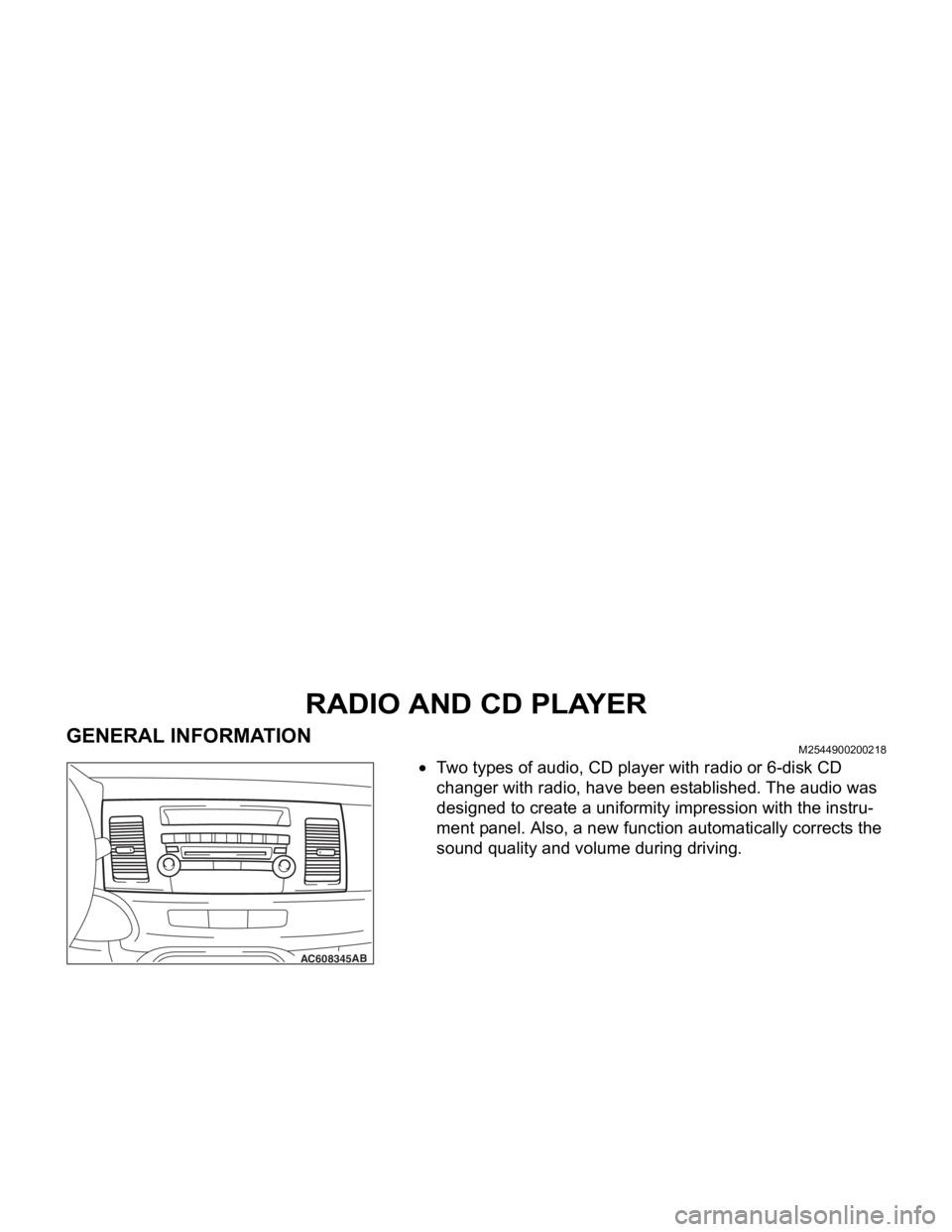
COLUMN SWITCH
CHASSIS ELECTRICAL54A-21
COLUMN SWITCH
GENERAL INFORMATIONM2546100200058
Column switch has a function to ensure the driver's
safety during frontal collision of vehicle..
Function
If the column switch is moved to the front of the vehi-
cle and hit on the instrument panel or meter bezel by
the frontal collision of vehicle, the steering wheel is
moved to the front of the vehicle because the right
and left levers fall down, ensuring the driver's safety.
In addition, the column switch secures the rigidity
that the levers do not fall down by the normal opera
-
tion, however, it cannot be reused after the deforma-
tion.
RADIO AND CD PLAYER
GENERAL INFORMATIONM2544900200218
•Two types of audio, CD player with radio or 6-disk CD
changer with radio, have been established. The audio was
designed to create a uniformity impression with the instru
-
ment panel. Also, a new function automatically corrects the
sound quality and volume during driving.
AC603959AB
Collision load Collision load
Column switch Column switch Front of vehicle
AC608345AB
Page 55 of 241
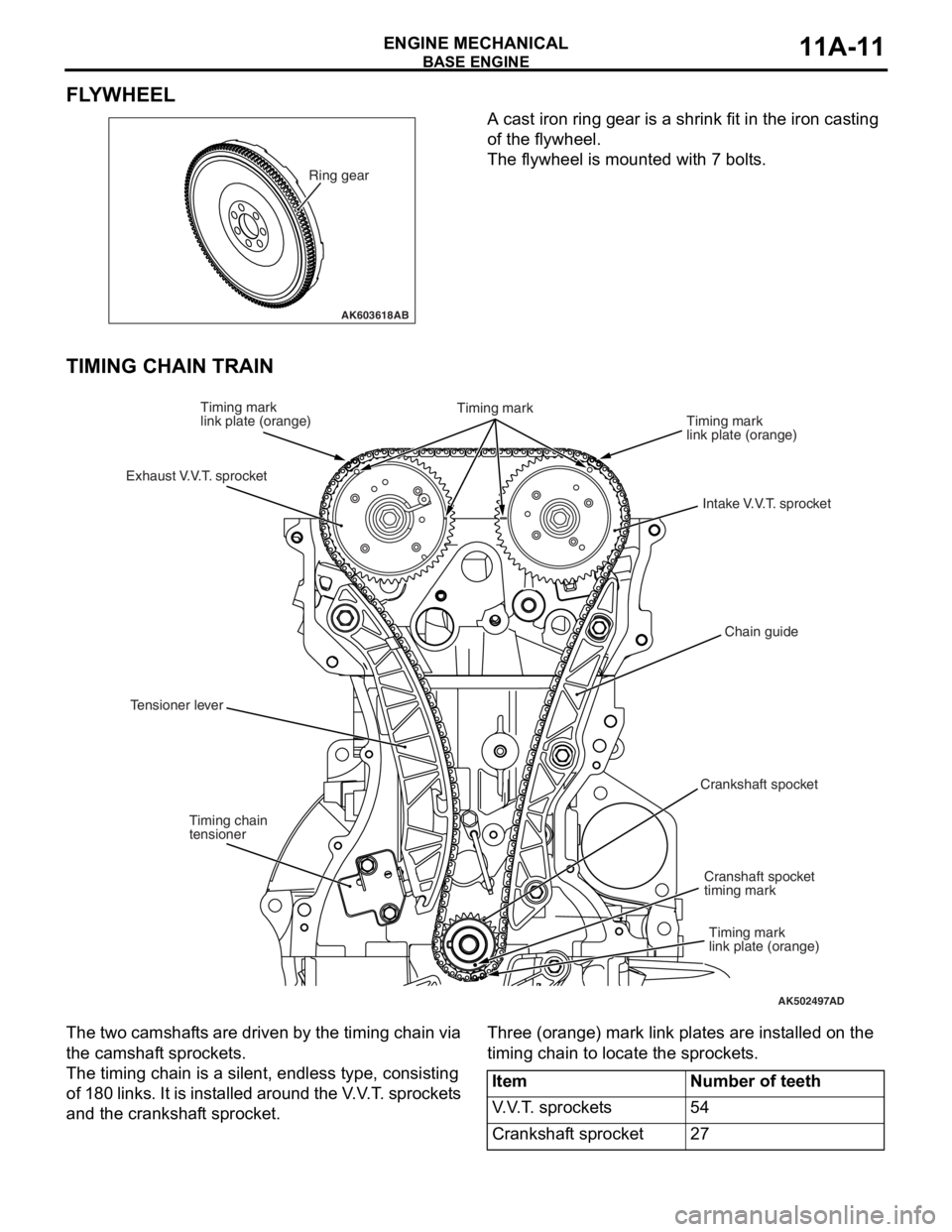
BASE ENGINE
ENGINE MECHANICAL11A-11
FLYWHEEL
A cast iron ring gear is a shrink fit in the iron casting
of the flywheel.
The flywheel is mounted with 7 bolts.
TIMING CHAIN TRAIN
The two camshafts are driven by the timing chain via
the camshaft sprockets.
The timing chain is a silent, endless type, consisting
of 180 links. It is installed around the V.V.T. sprockets
and the crankshaft sprocket.
Three (orange) mark link plates are installed on the
timing chain to locate the sprockets.
AK603618AB
Ring gear
AK502497
Timing mark
link plate (orange)Timing mark
Timing mark
link plate (orange)
Intake V.V.T. sprocket
Chain guide
Crankshaft spocket
Cranshaft spocket
timing mark
Timing mark
link plate (orange) Exhaust V.V.T. sprocket
Tensioner lever
Timing chain
tensioner
AD
ItemNumber of teeth
V.V.T. sprockets54
Crankshaft sprocket27
Page 56 of 241
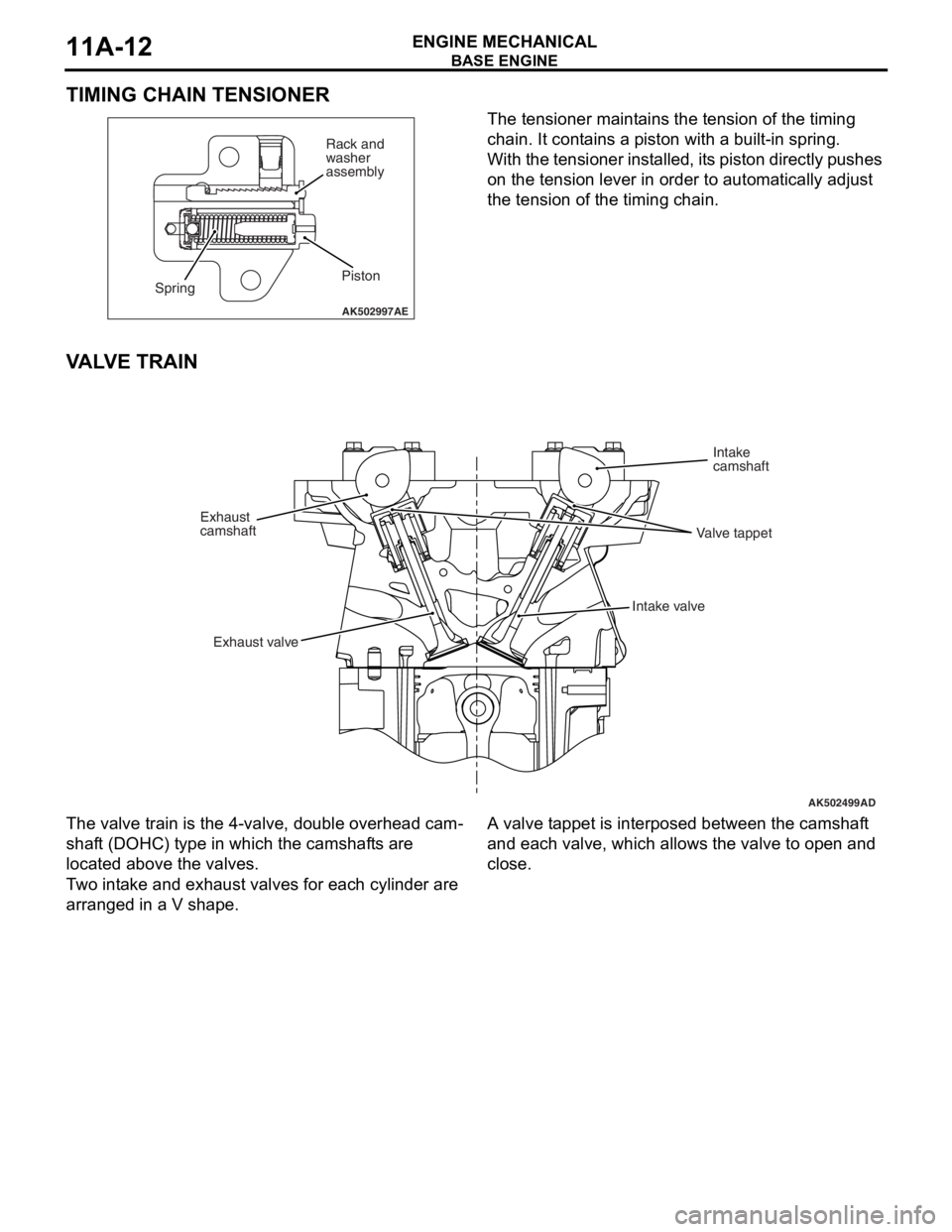
BASE ENGINE
ENGINE MECHANICAL11A-12
TIMING CHAIN TENSIONER
The tensioner maintains the tension of the timing
chain. It contains a piston with a built-in spring.
With the tensioner installed, its piston directly pushes
on the tension lever in order to automatically adjust
the tension of the timing chain.
VA LV E T R A I N
The valve train is the 4-valve, double overhead cam-
shaft (DOHC) type in which the camshafts are
located above the valves.
Two intake and exhaust valves for each cylinder are
arranged in a V shape.
A valve tappet is interposed between the camshaft
and each valve, which allows the valve to open and
close.
AK502997
SpringPiston
AE
Rack and
washer
assembly
AK502499
Exhaust
camshaftIntake
camshaft
Valve tappet
Intake valve
Exhaust valve
AD
Page 66 of 241

AUTO-CRUISE CONTROL SYSTEM
ENGINE AND EMISSION CONTROL17-4
COMPONENTS AND FUNCTIONS
ComponentFunction
Accelerator pedal position sensor (APP sensor)Informs the ECM of the accelerator pedal
depression.
Auto-cruise control switch"ON/OFF" switchPower switch for auto-cruise control system.
"ACC/RES" switchVehicle speed is set with the "ACC/RES" switch and
"COAST/SET" switch.
"COAST/SET" switch
"CANCEL" switchCancels the cruise speed setting.
Cancel systemClutch switch
the clutch operation, the clutch pedal status is
detected.
Stoplight switch•Because the constant speed driving is canceled
by the brake operation, it detects the brake pedal
status.
•As for the stoplight switch, two built-in switches,
the stoplight switch which is also used for the
stoplight illumination and the brake switch which
is used exclusively for the auto-cruise control, are
integrated, and thus the reliability is enhanced.
Transmission range
switch
the selector lever operation, it detects the "N"
position.
"CRUISE" indicator lightThe light is included in the combination meter and
illuminates when the "ON/OFF" switch is pressed
(auto-cruise control system: ON).
Data link connectorIf the M.U.T.-III scan tool is connected, the input
check code from the ECM can be read.
Engine control module (ECM)•Based on the input signal from each sensor and
switch, it outputs the throttle opening instruction
signal to the TAC motor.
•Based on the input signal from each sensor and
switch, it outputs the transaxle control signal to
the TCM
•Based on the vehicle speed signal from the
vehicle speed sensor, it calculates the vehicle
speed
•Based on the secondary pulley speed sensor
signal from the TCM, it calculates the vehicle
speed
•Based on the selector lever "N" position signal of
the transmission range switch from the ECM, it
cancels constant speed driving.
•Outputs the ON/OFF signals of "CRUISE"
indicator light and auto-cruise control system.
•The diagnostic trouble code signal is sent to the
"CRUISE" indicator light.
•The input check code is sent to the data link
connector.
Throttle actuator control motor (TAC motor)The throttle valve opens and closes in response to
the throttle angle signal from the ECM.
Page 67 of 241
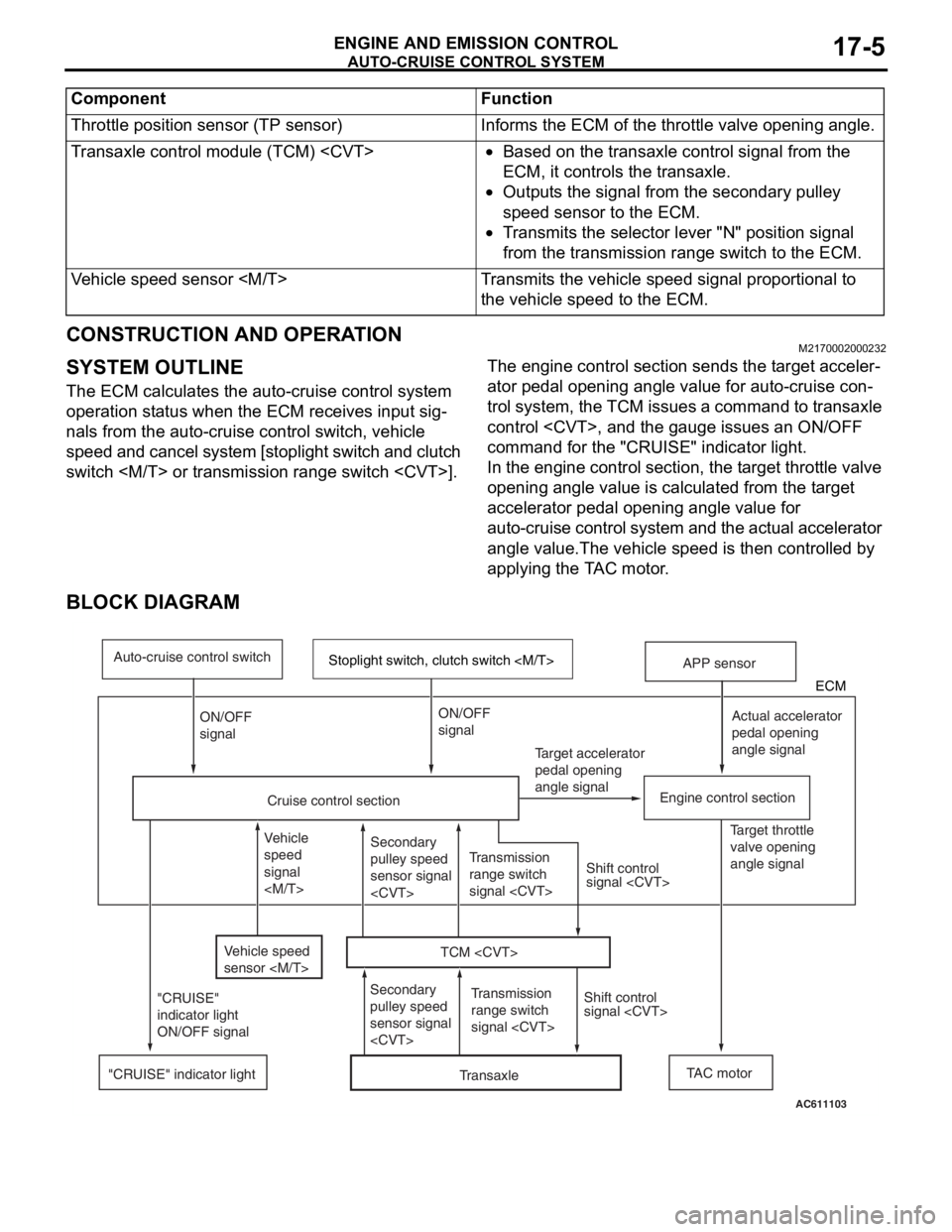
AUTO-CRUISE CONTROL SYSTEM
ENGINE AND EMISSION CONTROL17-5
CONSTRUCTION AND OPERATIONM2170002000232
SYSTEM OUTLINE
The ECM calculates the auto-cruise control system
operation status when the ECM receives input sig
-
nals from the auto-cruise control switch, vehicle
speed and cancel system [stoplight switch and clutch
switch
-
ator pedal opening angle value for auto-cruise con-
trol system, the TCM issues a command to transaxle
control
command for the "CRUISE" indicator light.
In the engine control section, the target throttle valve
opening angle value is calculated from the target
accelerator pedal opening angle value for
auto-cruise control system and the actual accelerator
angle value.The vehicle speed is then controlled by
applying the TAC motor.
BLOCK DIAGRAM
Throttle position sensor (TP sensor)Informs the ECM of the throttle valve opening angle.
Transaxle control module (TCM)
ECM, it controls the transaxle.
•Outputs the signal from the secondary pulley
speed sensor to the ECM.
•Transmits the selector lever "N" position signal
from the transmission range switch to the ECM.
Vehicle speed sensor
the vehicle speed to the ECM.
Component Function
TAC motor Target accelerator
pedal opening
angle signal
Engine control section
Cruise control section"CRUISE" indicator light
AC611103
Actual accelerator
pedal opening
angle signal
Shift control
signal
Target throttle
valve opening
angle signal
Auto-cruise control switch
ECM
Stoplight switch, clutch switch
TCM
"CRUISE"
indicator light
ON/OFF signal
APP sensor
Transmission
range switch
signal
signal
TransaxleTransmission
range switch
signal
Secondary
pulley speed
sensor signal
signalON/OFF
signal
Vehicle speed
sensor
Vehicle
speed
signal
pulley speed
sensor signal
Page 68 of 241

AUTO-CRUISE CONTROL SYSTEM
ENGINE AND EMISSION CONTROL17-6
SYSTEM FUNCTIONS
.
SET FUNCTION
1. During driving with the vehicle speed range from
approximately 40 to 200 km/h (25 to 125 mph),
press and release the "COAST/SET" switch.
2. The vehicle speed when the "COAST/SET" switch
is released is memorized. Thereafter, the constant
speed driving is performed at that vehicle speed.
3. When the "COAST/SET" switch is operated
during the driving with the vehicle speed of
approximately 200 km/h (125 mph) or more, the
constant speed driving will not be performed.
.
COAST FUNCTION
1. When the "COAST/SET" switch is continuously
pressed for 0.5 seconds or longer during constant
speed driving, the throttle valve becomes fully
closed while the switch is pressed, and the
vehicle is decelerated.
2. When the "COAST/SET" switch is released, the
vehicle speed at that time is now memorized.
Thereafter, the constant speed driving is
performed at that vehicle speed.
3. Also when the "COAST/SET" switch is pressed
for less than 0.5 second, the vehicle is
decelerated 1.6 km/h (1 mph) from the vehicle
speed of constant speed driving, and the
decelerated vehicle speed is now memorized.
Thereafter, the constant speed driving is
performed at that vehicle speed.
4. When the "COAST/SET" switch is continuously
pressed and the vehicle speed is decelerated to
approximately 40 km/h (25 mph) or less, the set
function and coast function are cancelled, and the
constant speed driving is cancelled.
.
RESUME FUNCTION
1. When the "CANCEL" switch is pressed or the
brake pedal is depressed during the constant
speed driving, it cancels the constant speed
driving.
2. Subsequently, when the "ACC/RES" switch is
pressed during driving with the vehicle speed of
approximately 40 km/h (25 mph) or more, the
constant speed driving is performed with the
vehicle speed memorized at the last cancellation
of constant speed driving.
.
ACCEL FUNCTION
1. When the "ACC/RES" switch is continuously
pressed for 0.5 second or more during constant
driving, it accelerates the vehicle with specified
acceleration while the switch is pressed.
2. Then, when the "ACC/RES" switch is released,
the vehicle speed at that time is now memorized.
Thereafter, the constant speed driving is
performed at that vehicle speed.
3. Also, when the "ACC/RES" switch is pressed for
less than 0.5 second, the vehicle is accelerated
1.6 km/h (1 mph) from the vehicle speed of
constant speed driving, and the accelerated
vehicle speed is now memorized. Thereafter, the
constant speed driving is performed at that
vehicle speed.
4. It is possible to keep pressing the "ACC/RES"
switch until the vehicle speed is accelerated to
approximately 200 km/h (125 mph) or above.
However, after the "ACC/RES" switch is released,
the vehicle speed of approximately 200 km/h (125
mph) becomes the newly memorized vehicle
speed. Thereafter, the constant speed driving is
performed at that speed.
.
CANCEL FUNCTION
When any of the following conditions are satisfied,
the constant speed driving will be cancelled.
•The auto-cruise control system is stopped by the
pressing the "ON OFF" switch.
•The "CANCEL" switch is pressed.
•The brake pedal is depressed.
•The clutch pedal is depressed
•The selector lever is shifted to the "N" position
•The vehicle speed becomes approximately 40
km/h (25 mph) or less.
•The vehicle speed is reduced 15 km/h (9 mph) or
more from the speed at which the constant speed
driving was started.
•An abnormality occurs in the vehicle speed sig-
nal.
•The engine coolant temperature becomes abnor-
mally high.
•An abnormality occurs to the ECM.
•An abnormality occurs to the TCM
•An abnormality occurs to the CAN communica-
tion.
.
Page 153 of 241

INSTRUMENT PANEL AND FLOOR CONSOLE
INTERIOR52A-4
•The decorated panel creating uniformity from the
instrument panel to the door trim has been
adopted.
•The holder in which two cards can be stored has
been installed in the glove box.
•The glove box with damper function has been
installed.
•The center tray for storing small items has been
installed in front of the selector or shift lever cen
-
ter panel.
•The cup holder which can hold two 20-oz bottles
has been equipped. The cup holder can store two
CDs in the upright position and pen-size long
items horizontally.
•Under the arm rest of type B, a large box that can
store 6 CDs has been equipped. (9 CDs for type
C)
•A tray that can store cigarettes and lighters has
been equipped.
•The synthetic cloth is used for the arm rest lid to
enhance luxury and soft feelings.
Page 155 of 241

SEAT
INTERIOR52A-6
•The seat frame and head restraint have been
installed to the proper positions to minimize the
severity of whiplash injury at rear-end collision at
a low speed. (Whiplash injury reduction seat
structure)
•The overall height mechanism raises and lowers
the seat cushion together with the seatback, thus
the driver's posture is always kept at the best
position, resulting in the improved riding comfort.
•The pump-type height lever has been adopted for
easier operation with a light force by the vertical
adjustment system. Also, the height adjustment
amount has been increased for more optimum
driving position.
•The variable hardness pad has been adopted for
the sporty-look seat with increased bucket
amount of side bolster in order to establish the
sporty shape with support function
the standard shape which is basic and for actual
use and comfortable driving.
•Heated seats are available for the driver's and
passenger's seats.
•The genuine leather for the seat has been
upgraded to enhance the texture and luxury feel
-
ing.
SPECIFICATIONS FOR HEATED SEAT
ItemSpecifications
ENERGY CONSUMPTION WHIGH61 ± 6.1
LOW16 ± 1.6
THERMOSTAT °CON → OFF40 ± 4
OFF → ON30 ± 5
Page 182 of 241
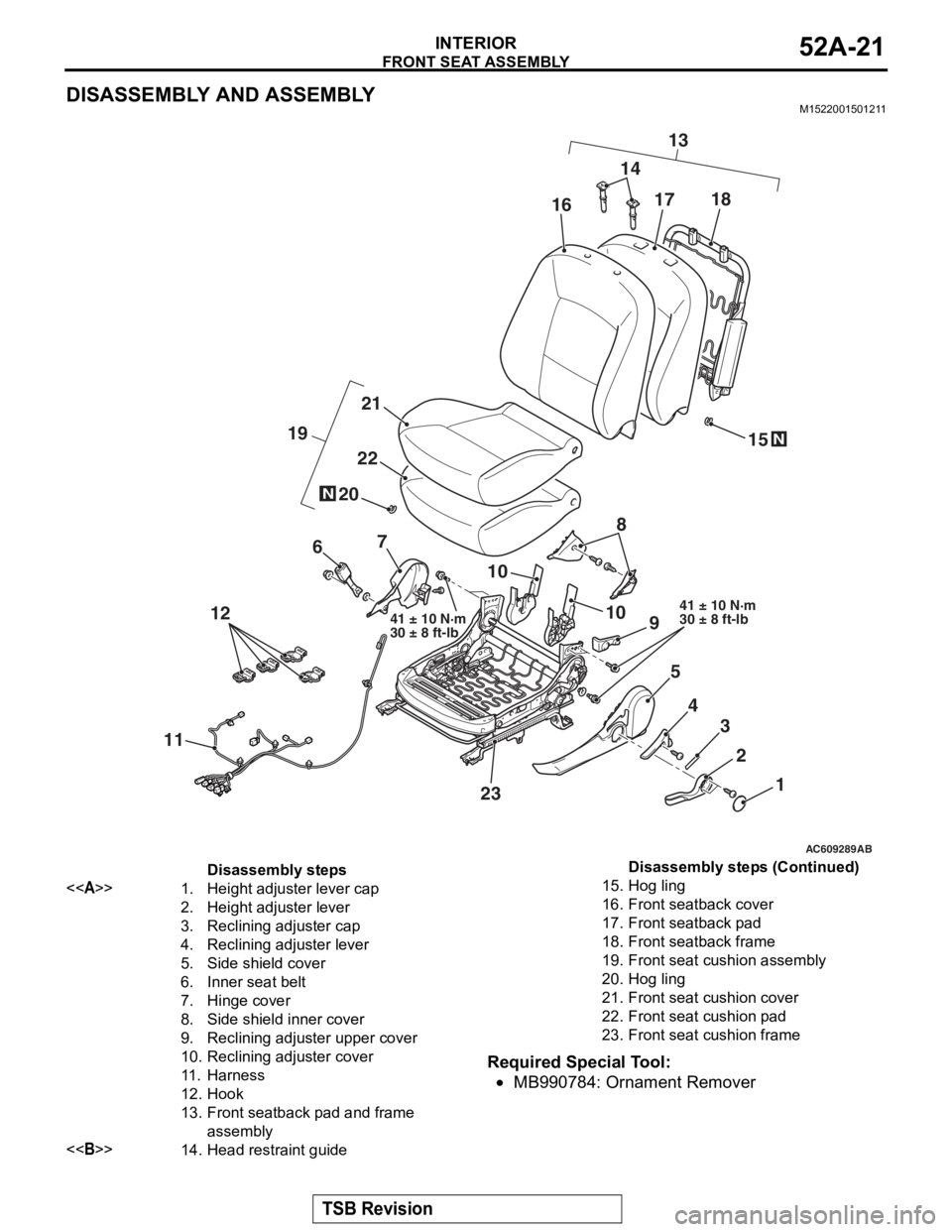
FRONT SEAT ASSEMBLY
TSB Revision
INTERIOR52A-21
DISASSEMBLY AND ASSEMBLYM1522001501211
Required Special Tool:
•MB990784: Ornament Remover
AC506551
AC609289AB
1
2
3
4
5
9
10
67
12
11
23 14
13
N
10
20
19N
22
21
15
8
161718
41 ± 10 N·m
30 ± 8 ft-lb41 ± 10 N·m
30 ± 8 ft-lb
Disassembly steps
<>1.Height adjuster lever cap
2.Height adjuster lever
3.Reclining adjuster cap
4.Reclining adjuster lever
5.Side shield cover
6.Inner seat belt
7.Hinge cover
8.Side shield inner cover
9.Reclining adjust er upper cover
10.Reclining adjuster cover
11 .Harness
12.Hook
13.Front seatback pad and frame
assembly
<>14.Head restraint guide
15.Hog ling
16.Front seatback cover
17.Front seatback pad
18.Front seatback frame
19.Front seat cushion assembly
20.Hog ling
21.Front seat cushion cover
22.Front seat cushion pad
23.Front seat cushion frame
Disassembly steps (Continued)
Page 183 of 241
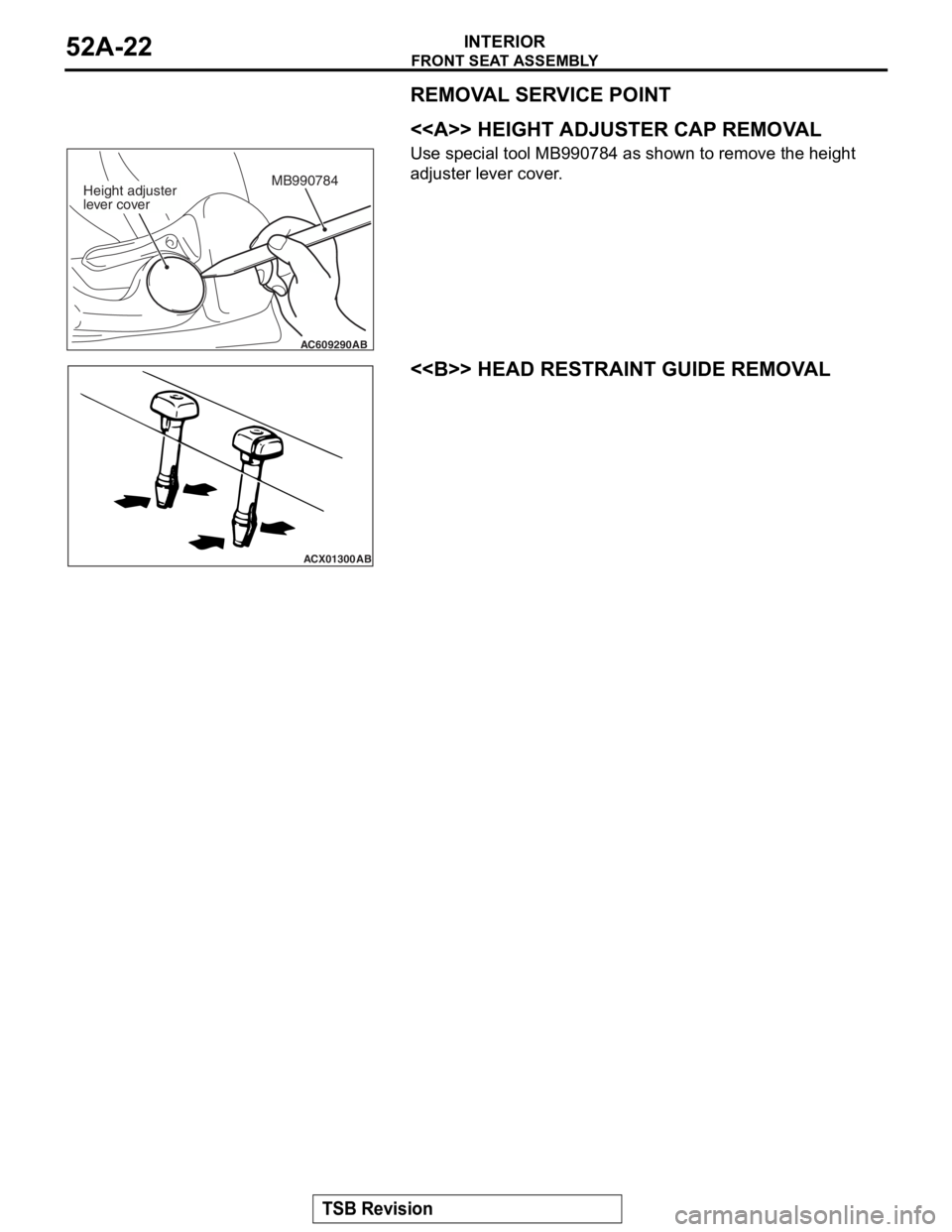
FRONT SEAT ASSEMBLY
TSB Revision
INTERIOR52A-22
REMOVAL SERVICE POINT
.
<> HEIGHT ADJUSTER CAP REMOVAL
Use special tool MB990784 as shown to remove the height
adjuster lever cover.
.
<> HEAD RESTRAINT GUIDE REMOVAL
AC609290
MB990784
AB
Height adjuster
lever cover
ACX01300AB